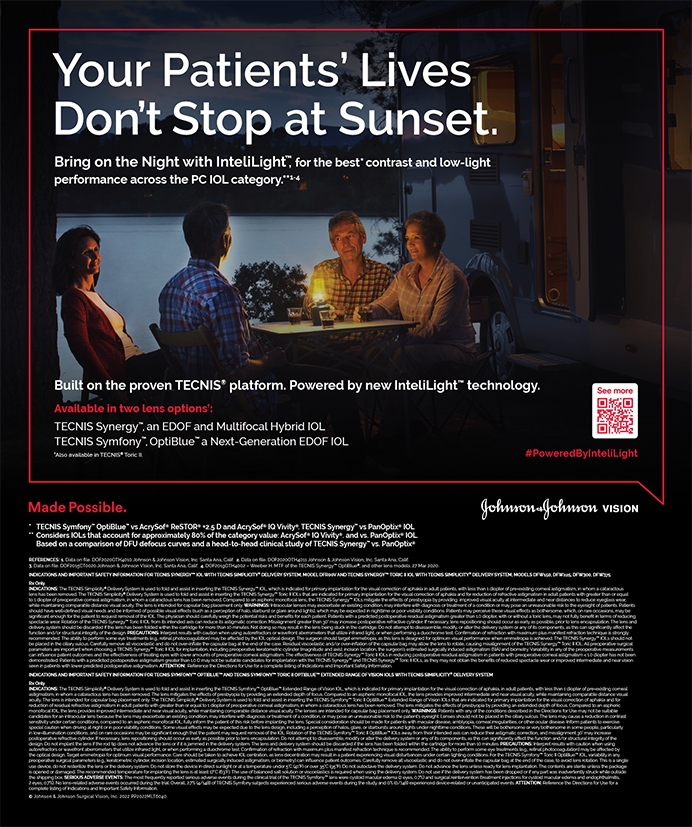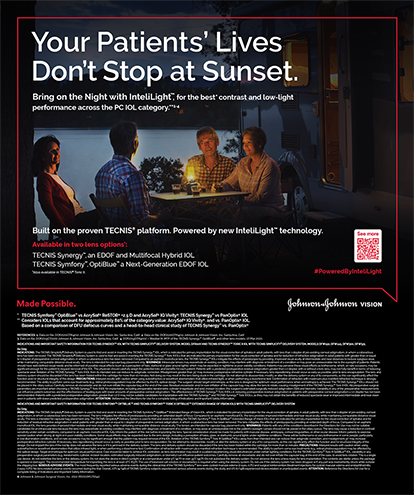I will never forget the first case of ultrasound phacoemulsification performed on a human. The surgery occurred in mid-1967 and was scheduled to take place in OR No. 7 at the Manhattan Eye, Ear & Throat Hospital. Strong opposition to Dr. Kelman's work came from the Board of Surgeon Directors, especially then-chairman Herbert Katzin, MD. Dr. Kelman chose a date for the operation when the chairman would not be at the hospital. As the room was being prepared, however, the chairman appeared in the OR, and Charlie nearly had a heart attack. Fortunately, the chairman's visit was brief and Dr. Kelman's case unnoticed.
The surgery took more than 4 hours, with 61 minutes of ultrasound time from a handpiece that weighed nearly 4 pounds and was supported from the ceiling by guide-wires. Dr. Kelman's work, which forever changed cataract surgery, was not widely adopted until the early 1980s, when a foldable IOL was introduced. In other words, the success of phacoemulsification was closely allied with implant technology. This article focuses on advances in the latter field.
EARLY LENS DESIGNS
The Sputnik and Binkhorst Lenses
I finished my ophthalmology residency in 1967 and took a position as Resident Instructor at the New York Medical College in Upper Manhattan. The department's chairman was then Miles Galin, MD, an ophthalmologist who assumed the position at age 33. He traveled frequently to Moscow to visit his friend Svyatoslav Fyodorov, MD, who, in turn, visited Dr. Galin in New York. Slava had developed an early version of the pupillary support lens, dubbed the Sputnik lens (Figure 1), simply because it had many antenna-like haptics protruding from its optic such that it resembled the Sputnik spacecraft. At that time, the Soviets led the space race. Dr. Galin began implanting these lenses, and the immediate visual results were dramatic. My serious interest in implants was born.
I implanted my first IOL (one of the Sputnik lenses) in August 1968, and I followed that patient, who did well for 4 years until developing early corneal decompensation. Nothing much happened on the New York scene until early pioneers such as Herve Byron, MD, made a trip to the Netherlands in April 1967 to visit Cornelius Binkhorst, MD, and observe his work. Herve returned to New York and commenced implanting the Binkhorst four-loop lenses later that summer (Figure 2). I began implanting them in 1969.
The Medallion Lens
In 1974, I decided to travel to Groningen, the Netherlands, with Jerome Levy, MD, and Tony Pisacano, MD, from New York, to visit Jan Worst, MD, who was actively engaged in lens implantation. His favorite was the Medallion lens, which he had designed. This implant was attached to the iris superiorly by a suture and two haptics that were posterior to the iris. Dr. Worst was producing these lenses at his own facility, called the Medical Workshop.
My colleagues and I were fascinated by what we saw in the Netherlands, and I subsequently returned to New York with a bagful of Medallion lenses, which were primarily 19.50D. One should understand that biometry was not yet available, and the rationale for these lenses of estimated power was that a few diopters of postoperative hyperopia or myopia were far preferable to the 12.00D or more of hyperopia from aphakia. We had lenses of other powers that we would use by factoring in the patient's preoperative refractive state, if we could determine it prior to the onset of nuclear sclerosis.
The Medallion lenses were my first IOL of choice. The early days of implanting them were interesting. The lenses came in a vial of sodium hydroxide, which was supposed to keep them sterile. Prior to implantation, the glass vial was broken open, and the lens was bathed in bicarbonate to “neutralize” the hydroxide. Then, the lens was copiously washed with irrigating solution to remove chemical residue.
The Copeland Lens
Also in the early 1970s, a local optician, Michael Copeland, began producing the Copeland Lens, which was basically an iteration of the South African Epstein design. I implanted three and realized early that the design was flawed. Iris atrophy from the haptics quickly ensued, along with early corneal decompensation.
Comments
I should note that my early experience with lens implantation occurred before viscoelastics and well before Herbert Kaufman, MD, discovered the negative effect of endothelial contact with PMMA. It may well have been surgical technique and not the design that sank many early lens implant designs.
I began to realize that the Binkhorst four-loop lens was a preferable design to the Medallion and returned to implanting the former following intracapsular surgery. The Binkhorst design had its problems: the lens would often luxate when the pupil was dilated. I remember several instances of dilating an eye with a subluxated lens, positioning the patient until the haptics were aligned with the pupil, and then constricting the pupil. Early on, I implanted these lenses without iris fixation. I later began fixing the anterior superior haptic to the peripheral iris at the 12-o'clock position with a suture by means of the McCannel technique.
SUPPORT AND CONTROVERSY
I began to draw interest at the Manhattan Eye, Ear & Throat Hospital as the only implanter of IOLs. Most staff members were supportive. One by one, I began to teach those who had an interest in pseudophakia and assisted them on their early cases.
I did, however, have my detractors. I had recently been inducted into the Manhattan Ophthalmological Society, a rather prestigious organization limited to 35 members from the various institutions around town. At about the same time, the science section of the New York Times ran a story on the new phenomenon of lens implantation and highlighted my work. A senior member of the society began a movement to have me ousted from the organization, but he did not have enough support. It is interesting to note that, 10 years later, he asked me to perform cataract surgery on his wife and implant a lens, which I did.
ADVANCES
Lenses
In November 1977, I attended a symposium in San Francisco at which Steven Shearing, MD, introduced the PCIOL to be implanted after extracapsular surgery. I immediately became a convert.
Until 1977, all lenses were made of PMMA. That year brought the introduction of a glass implant produced by Lynell (Figure 3). The IOL made sense, because its optic was one-third the thickness of an equivalent PMMA lens and the lens' surface was not conducive to the formation of precipitates. The lens was short-lived, however, because the Nd:YAG laser was introduced and cracked the lens in a few eyes.
The Field
By 1978, approximately a dozen surgeons in and around New York, each operating at different facilities, were implanting IOLs. So that we could learn from each other, we formed the New York IOL Club and met monthly over dinner to compare notes.
My technique and choice of implants have continued to evolve in response to further developments in the field. They include routine ultrasound phacoemulsification, foldable implants, clear corneal incisions, and bimanual microincisional cataract surgery using laser technology.
Conclusion
I have had a tremendous journey of almost 40 years since my first implantation of an IOL. The experience has proved to be one of the greatest rides in my life, during which I saw great benefits accrue to the most important person in the equation—the patient.
Section Editor Herve M. Byron, MD, is Clinical Professor for the Department of Ophthalmology at the New York University School of Medicine in New York. Dr. Byron may be reached at (212) 249-8494; byronmd@mac.com.
Jack M. Dodick, MD, is Professor and Chairman of the Department of Ophthalmology at New York University School of Medicine, and he is Chairman of the Department of Ophthalmology at Manhattan Eye, Ear & Throat Hospital. He states that he holds no financial interest in the products or companies mentioned herein. Dr. Dodick may be reached at (212) 288-7638; jackdodick@aol.com.


